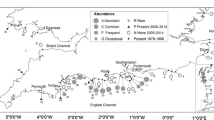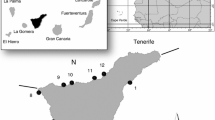Abstract
Diadema antillarum populations at many Caribbean locations have failed to recover from a wide-spread mortality event during the early 1980s. Quantitative assessments of Diadema in Dominica have only recently begun and can now be put into a regional context. Diadema and benthic algae were monitored in 4-month intervals at six 100 m2 sites, spread over a distance of 38 km, along the west coast of Dominica. Diadema density surveys began in July 2001, while algal cover was monitored as of November 2001. Mean densities of individual sites ranged from 0.81 m−2 (SD=1.02) to 2.98 m−2 (SD=1.33), and overall means increased from 1.50 m−2 (SD=0.12) in 2001, to 2.00 m−2 (SD=0.05) in 2004. The weak negative relationship observed between the Diadema density and macroalgal cover (R 2=0.25, P=0.0030), indicates that Diadema play a limited role in controlling macroalgal species. In contrast, the abundance of turf algae was positively related to low Diadema densities, yet this relationship becomes negative beyond a critical point between 2.0 and 3.0 Diadema per m2 (R 2=0.25, P=0.0075). As of November 2001 size measurements of 100 randomly sampled urchins at each site were included in the surveys, resulting in overall mean test size diameters ranging between 5.54 cm (SD=1.55) and 6.00 cm (SD=0.96). The mean test size diameter per site ranged from 4.54 cm (SD=1.91) at Tarou Point in November 2003 to 6.77 cm (SD=0.83) at Salisbury November 2001. Across all sites except Tarou Point, the most commonly occurring Diadema sizes throughout this study were within 1 cm, in the range between 4.5 and 7.5 cm. It is unclear how this Dominica scenario fits into the context of the pathogen-induced mass mortality events of the 1980s because neither qualitative nor quantitative records exist for that time in Dominica. The recent increase in Diadema density may be a symptom of recovery from Hurricane Lenny. Given the indiscriminant local pressure (affecting herbivorous fishes as well as fish predators of Diadema) Diadema’s role as grazer of algal turfs is highlighted. On a regional scale, its stable population of reproductive size classes may serve as source of larvae for nearby downstream islands.







Similar content being viewed by others
References
Bak RPM (1985) Recruitment patterns and mass mortalities in the sea urchin Diadema antillarum. Proc 5th Int Coral Reef Symp, Tahiti 5:267–272
Bak RPM, Carpay MJE, Ruyter van Steveninck ED (1984) Densities of the sea urchin Diadema antillarum before and after mass mortalities on the coral reefs of Curacao. Mar Ecol Prog Ser 17:105–108
Bauer JC (1976) Growth, aggregation, and maturation in the echinoid, Diadema antillarum. Bull Mar Sci 26(2):273–277
Bauer JC (1980) Observations on geographical variations in population density of the echinoid Diadema antillarum within the western North Atlantic. Bull Mar Sci 30(2):509–515
Carpenter RC (1990) Mass mortality of Diadema antillarum. I. Long-term effects of sea urchin population-dynamics and coral reef algal communities. Mar Biol 104:67–77
Chiappone M, Miller SL, Swanson DW, Ault JS, Smith SG (2001) Comparatively high densities of the long-spined sea urchin in the Dry Tortugas, Florida. Coral Reefs 20(2):137–138
Eckert GL (1998) Larval development, growth and morphology of the sea urchin Diadema antillarum. Bull Mar Sci 63(2):443–451
Edmunds PJ, Carpenter RC (2001) Recovery of Diadema antillarum reduces macroalgal cover and increases abundance of juvenile corals on a Caribbean reef. Proc Natl Acad Sci USA 98:5067–5071
Forcucci D (1994) Population density, recruitment and 1991 mortality event of Diadema antillarum in the Florida Keys. Bull Mar Sci 54:917–928
Highsmith RC (1982) Induced settlement and metamorphosis of the sand dollar (Dendraster excentricus) larvae in predator-free sites: adult sand dollar beds. Ecology 63:329–337
Hughes TP (1994) Catastrophes, phase shifts and large scale degradation of a Caribbean coral reef. Science 256:1547–1551
Hughes TP, Keller BD, Jackson JBC, Boyle MJ (1985) Mass mortality of the echinoid Diadema antillarum Philippi in Jamaica. Bull Mar Sci 36(2):377–384
Hughes TP, Reed DC, Boyle MJ (1987) Herbivory on coral reefs: community structure following mass mortalities of sea urchins. J Exp Mar Biol Ecol 113:39–59
Hunte W, Younglao D (1988) Recruitment and population recovery of Diadema antillarum (Echinodermata; Echinoidea) in Barbados. Mar Ecol Prog Ser 45:109–119
Hunte W, Cote I, Tomascik T (1986) On the dynamics of the mass mortality of Diadema antillarum in Barbados. Coral Reefs 4:135–139
Karlson RH, Levitan DR (1990) Recruitment-limitation in open populations of Diadema antillarum: an evaluation. Oecologia 82:40–44
Komoroske L (2002) Predatory and grazing fish associated with Diadema antillarum in western Dominican coral reefs. ITME Res Rep 12(3):15–20
Lessios HA (1988a) Mass mortality of Diadema antillarum in the Caribbean: what have we learned? Annu Rev Ecol Syst 19:371–393
Lessios HA (1988b) Population dynamics of Diadema antillarum (Echinodermata: Echinoidea) following mass mortality in Panama. Mar Biol 99:515–526
Lessios HA (1995) Diadema antillarum 10 years after mass mortality: still rare, despite help from a competitor. Proc R Soc Lond B 259:331–337
Lessios HA (2005) Diadema antillarum populations in Panama twenty years following mass mortality. Coral Reefs 24:125–127
Lessios HA, Robertson DR, Cubit JD (1984) Spread of Diadema mass mortality throughout the Caribbean. Science 226:335–337
Levitan DR (1988) Asynchronous spawning and aggregative behavior in the sea urchin Diadema antillarum (Philippi). In: Burke RD et al (eds) Echinoderm biology. Balkema, Rotterdam, pp 181–186
Lewis JB (1966) Growth and breeding in the tropical echinoid Diadema antillarum Phillipi. Bull Mar Sci 16(1):151–158
Liddell WD, Ohlhorst SL (1986) Changes in benthic community composition following the mass mortality of Diadema at Jamaica. J Exp Mar Biol Ecol 95:271–278
Miller RJ, Adams AJ, Ogden NB, Ogden JC, Ebersole JP (2003) Diadema antillarum 17 years after mass mortality: is recovery beginning on St. Croix? Coral Reefs 22:181–187
Moses CS, Bonem RM (2001) Recent population dynamics of Diadema antillarum and Tripneustes ventricosus along the north coast of Jamaica, WI. Bull Mar Sci 68(2):327–336
Ogden JC, Brown RC, Salesky N (1973) Grazing by the echinoid Diadema antillarum. Formation of halos around West-Indian patch reefs. Science, Wash 182:715–717
Pearce CM, Scheibling RL (1990) Induction of settlement and metamorphosis in the sand dollar Echinarachnius parma: evidence for an adult-associated factor. Mar Biol 107:363–369
Petterson L (2002) Fish and invertebrate predators of Diadema antillarum in Dominica. ITME Res Rep 12(4):21–25
Phinney JT, Muller-Karger F, Dustan P, Sobel J (2001) Using remote sensing to reassess the mass mortality of Diadema antillarum 1983–1984. Conserv Biol 15:885–891
Steiner SCC (2003) Stony Corals and Reefs of Dominica (Lesser Antilles). Atoll Res Bull 498
Acknowledgments
We thank E. Mastagni and T. Milloy for their help in the initial set up of the monitoring sites. J. Borger, P. Yoshioka, C. Moses and two anonymous reviewers provided helpful critiques of the manuscript. This project was funded by the Institute for Tropical Marine Ecology, Inc. (ITME RP04-01).
Author information
Authors and Affiliations
Corresponding author
Additional information
Communicated by P.W. Sammarco, Chauvin
Rights and permissions
About this article
Cite this article
Steiner, S., Williams, S. The density and size distribution of Diadema antillarum in Dominica (Lesser Antilles): 2001–2004. Mar Biol 149, 1071–1078 (2006). https://doi.org/10.1007/s00227-006-0279-3
Received:
Accepted:
Published:
Issue Date:
DOI: https://doi.org/10.1007/s00227-006-0279-3




